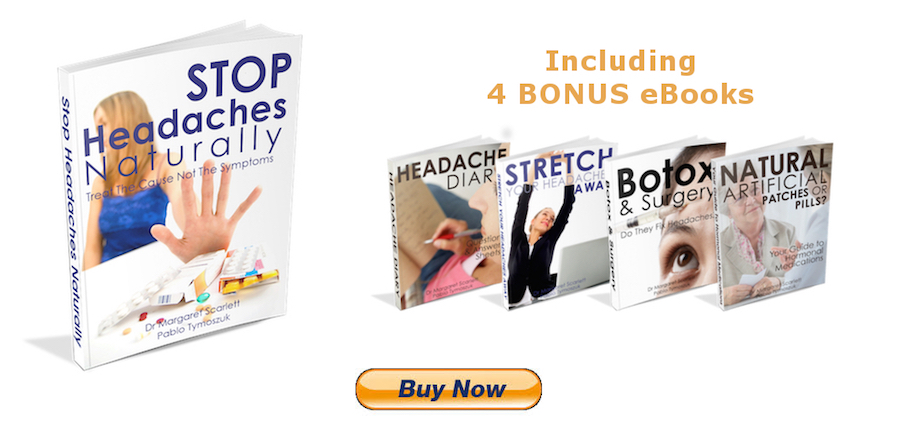Does Adding Epsom Salts To Your Bath Ease Muscle Pain?

Adding Epsom salts can make your bath more effective. This is an old home remedy for easing muscle pain which is still widely used today. It is not just an old wives’ tale – there are good reasons for thinking it will help your muscles and your headaches.
Epsom salts act as a source of magnesium ions. These play an essential role in body chemistry, including the maintenance of normal functioning of nerves and muscles.
"Epsom salts act as a source of magnesium ions… including the maintenance of normal functioning of nerves and muscles."
Many headache sufferers have lower than normal levels of magnesium ions in their blood and brain [5,6,7,8] and intravenous magnesium will often quickly relieve a headache attack.[8,9]
Magnesium ions can also enter the bloodstream by absorption across the skin [10,11]. A small study showed that soaking in an Epsom salt bath for 12 minutes two times a week should be sufficient to restore normal levels.[11] The effects on headaches have not been studied but it seems well worth trying.
"Many headache sufferers have lower than normal levels of magnesium."
You will need about 2 cups of Epsom salts in a standard sized bath tub.
If you suffer from migraines, you may have noticed that your hands and feet tend that tend to get colder before and during an attack.
For many people this is a reliable early warning sign.
A warm bath taken at this stage will help prevent the attack from progressing further by drawing blood away from your head towards your extremities.
This is an excerpt from the ebook Stop Headaches Naturally - Chapter 11.15 - Heat, Cold and other Therapies
References:
[5] P Sarchielli, G Coata, C Firenze, P Morucci, G Abbritti and V Gallai (1992). “Serum and salivary magnesium levels in migraine and tension-type headache. Results in a group of adult patients.” Cephalalgia 12(1): 21-27.
[6] BM Altura and BT Altura (1996). “Role of magnesium in patho-physiological processes and the clinical utility of magnesium ion selective electrodes.” Scand J Clin Lab Invest Suppl 224: 211-234.
[7] A Mauskop, BT Altura, RQ Cracco and BM Altura (1993). “Deficiency in serum ionized magnesium but not total magnesium in patients with migraines. Possible role of ICa2+/IMg2+ ratio.” Headache 33(3): 135-138.
[8] A Mauskop and BM Altura (1998). “Role of magnesium in the pathogenesis and treatment of migraines.” Clin Neurosci 5(1): 24-27.
[9] A Mauskop, BT Altura, RQ Cracco and BM Altura (1996). “Intravenous magnesium sulfate rapidly alleviates headaches of various types.” Headache 36(3): 154-160.
[10] H Laudańska, A Lemancewicz, M Kretowska, T Reduta and T Laudański (2002). “Permeability of human skin to selected anions and cations--in vitro studies.” Commun Mol Pathol Pharmacol 112(1-4): 16-26.
[11] Dr RH Waring (2009). “Report on Absorption of magnesium sulfate (Epsom salts) across the skin.”
Botox - Beware The Hype

When preventative medication for headaches doesn’t work very well (which it often doesn’t) Botox and nerve decompression surgery may be promoted as alternatives.
They can seem to hold out the promise of an end to pain. When reports in the media have titles like “How cutting out your 'frown muscles' stops migraines - and wrinkles”[39] success seems assured and risks insignificant.
Yet Botox is the trade name for one form of botulinum toxin, a nerve poison produced by bacteria, and the most poisonous substance known. It is over 10,000 times more lethal than the venom of the world’s most poisonous snake – Australia’s own inland taipan.
"A nerve poison produced by bacteria… the most poisonous substance known."
Both cause muscle paralysis by the same mechanism. Death is due to paralysis of the breathing muscles.
Risks with Botox are minimised by only injecting minute amounts into several different places within same muscle, but it can still spread some distance from the injection site. For most people the benefits for headaches are small, and injections must be repeated every 2 – 3 months when nerve terminals regrow.
[39] D. Hurst (2010). “How cutting out your 'frown muscles' stops migraines – and wrinkles.” MailOnline, 31 August 2010.
This is an excerpt from Stop Headaches Naturally Chapter 9.29 - Botox and Nerve Decompression Surgery - Beware The Hype
It is important to understand that Botox only treats the symptoms and does not address the cause of migraine pain.
Clinical trials that lead to the approval of Botox for migraines requires the use of the PREEMT protocol, where small injections of multiple units are injected over the forehead, sides of the head and back of the head and neck.
"Botox only treats the symptoms"
The cost of this treatment is around $700 and has to be repeated every 3 months. Now that is an expensive way to find temporary pain relief.
If you suffer from migraines and chronic headaches and are considering using Botox, I encourage you to purchase my book called Stop Headaches Naturally. It only costs $27… a drop in ocean compared to the ongoing costs of Botox.
You will learn not only how to find pain relief but more importantly how to treat the cause of your pain and stop your headaches from returning.
The Promise - The Lure Of The Quick Fix
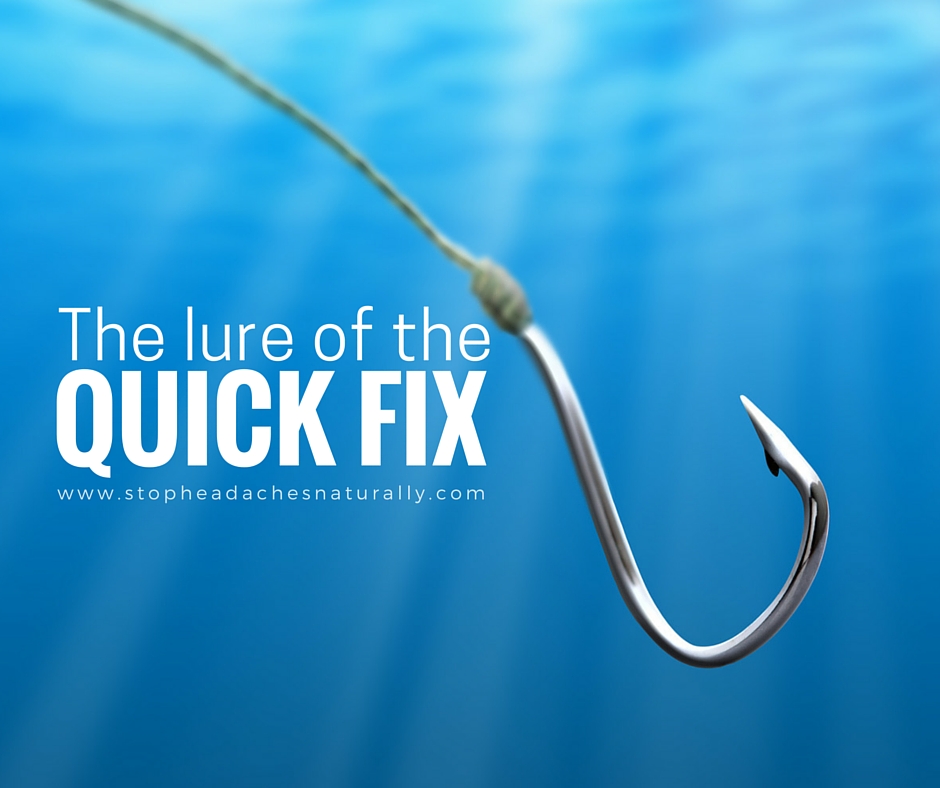
Our pre-occupation as a society with the short term quick fix is one of the factors responsible for over-reliance on pain-killers.
When time is money and a “can do” attitude is paramount, we may feel we can’t afford to be ill or to be functioning below our best.
Instead of taking time out to look after our health, when something goes wrong we look to medication to fix the problem.
"We look to medication to fix the problem"
The following quote typifies the “pop a pill and forget it” attitude that is so prevalent:
"It's never a great start to the day when you wake up with a pounding headache. Fortunately, help is often as close as your medicine cabinet. You can pop a couple of aspirin, close your eyes, and, in all likelihood, that throbbing in your head will be soothed within the hour.
You’re in good company in your choice of remedy. Some 80 billion aspirin tablets are taken worldwide, every year, for all types of headaches including the excruciatingly painful form known as a migraine. That's a lot of pharmacological muscle."
If you think this was written by an advertising executive for a pharmaceutical company you would be incorrect.
Disturbingly, it was actually taken from a reputable internet site offering health advice to the general public.
However there is no doubt that pharmaceutical advertising helps foster the idea that medication can provide solutions to all of your health problems.
This is an excerpt from Stop Headaches Naturally Chapter 6.6 - The promise - the lure of the quick fix
The Perfect Plank
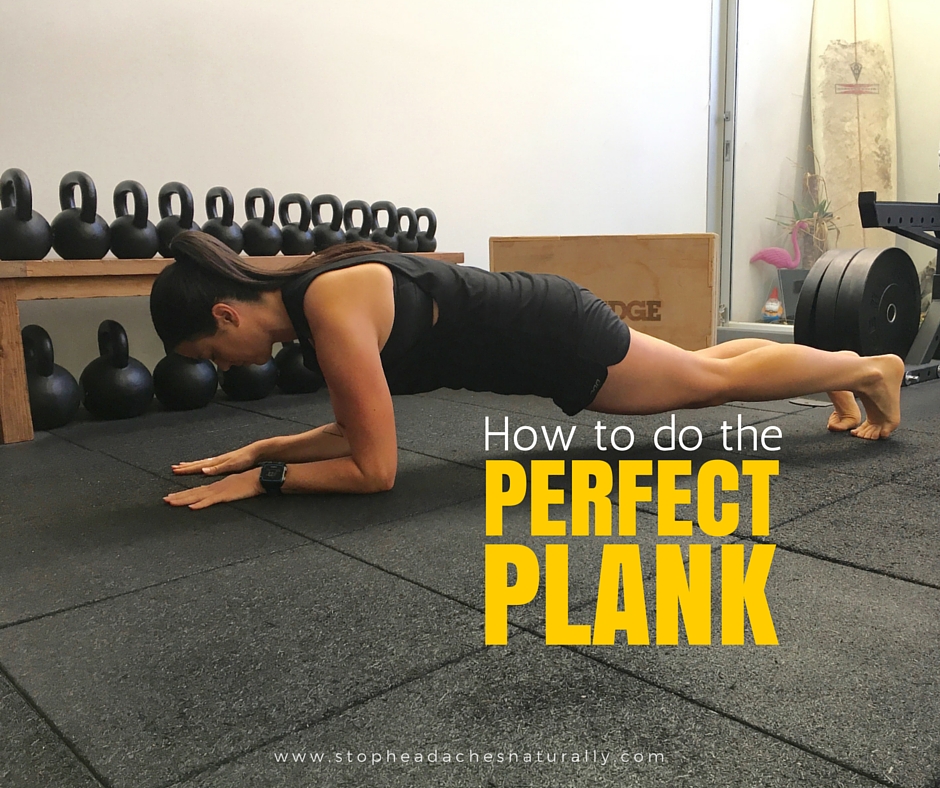
When performing the plank it is important to use the correct technique. This will allow you to get the most out of the exercise and reduce the risk of injury.
That is why I contacted Amber Johnson - Founder, Owner and Strength & Conditioning Coach at First Wave Fitness and asked her, "How do you perform the perfect plank?" Here is Ambers' response…
The plank is a brilliant exercise to learn to create and maintain tension throughout the core in a neutral spine position.
Here is how to set up your plank:
1. Setting up on your elbows, feet together, knees locked out straight and your weight evenly distributed throughout your body
2. Align elbows directly underneath your shoulders with forearms parallel, hands relaxed, palms facing down
3. From here, we want to pack our shoulders down into our ribcage and away from your ears. Without moving your forearms, imagine pulling them backwards along the floor to lock your upper body and pelvis together as one unit
4. To align your spine in a neutral position, find the best position where you can squeeze your glutes
5. Your head and neck should also be kept in a neutral position (you may wish to place a broomstick down your back to ensure correct alignment is maintained. With the stick making contact at the back of your head, upper back and glutes).
Engage your core by gently drawing the belly button in and exhaling slowly to hold a strong tension through the middle of your body. From here, take slow, small breathes in and gently exhale to maintain this tension.
When attempting the plank, you should always aim for quality over quantity. When you first set out, run through your mental checklist of form cues and aim for short intervals.
"Always aim for quality over quantity"
Initially you may wish to start with 10 seconds holds and 10 seconds rest to reset and come up again. Try to work towards 6x 10 seconds holds and gradually build the working interval as you feel more confident with your form.
Once you have conquered the 6x 10 seconds hold, a good goal is to build towards a 30 seconds quality hold. As you advance, aim for quality holds between 30-60 seconds, and eventually 60 seconds-2 minute holds.
For those who are looking to advance the plank from here and challenge their Cross Core Sling Systems try the following:
Single Arm Holds
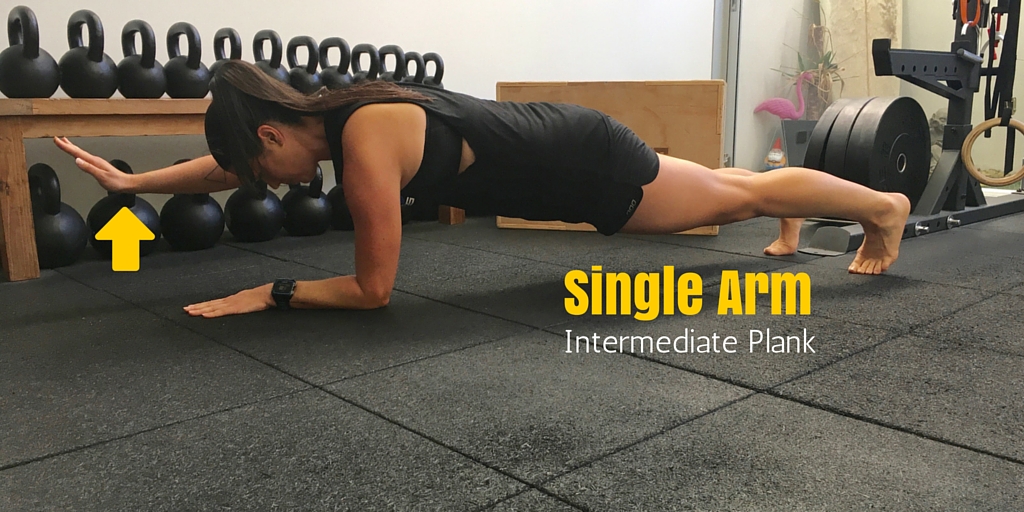
Single Leg Holds
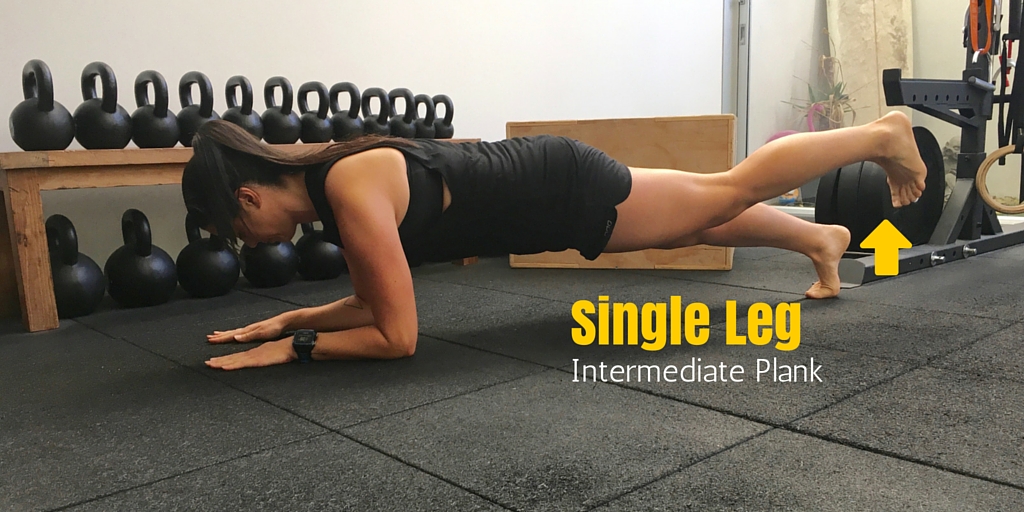
And the real challenge the…
Single Arm and Opposite Leg Hold
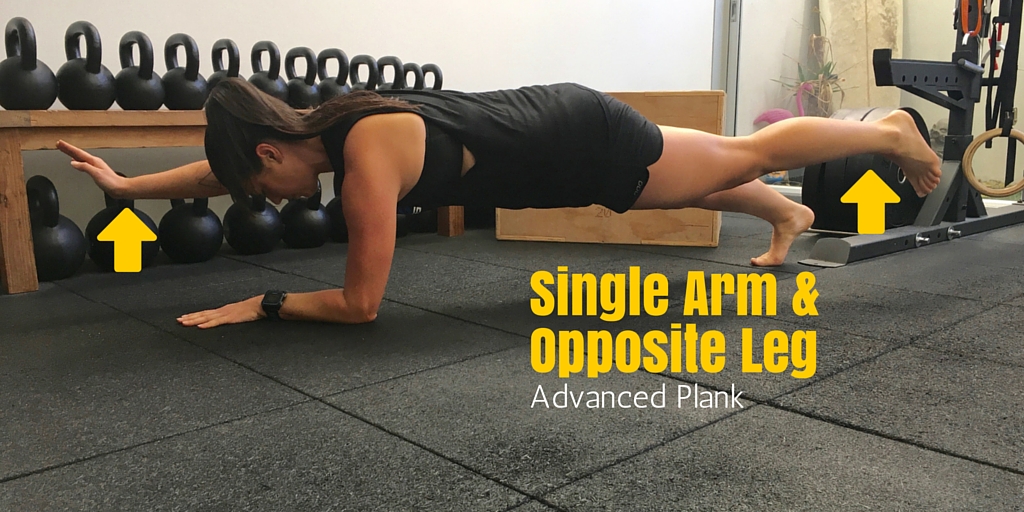
Look to progress these in the same fashion as the plank, small intervals of quality over duration. As you build in strength, build the working intervals into longer holds.
_________________________________
Amber Johnson has been working in the fitness industry now for close to 10 years. Originating from a strength and conditioning background, Amber now regularly trains for and participates in the long course and Ironman triathlon series.
After completing further studies in rehabilitation, functional movement and postural correction, Amber works with a suite of athletes both local and professional, to educate, identify and retrain imbalances in the body’s movement patterns to help them move more efficiently and effectively.
Amber’s training philosophy is about building a solid foundation of strength and stability for her athletes to maintain optimum posture across each discipline allowing the body to perform at its full potential which can be summed up in her favourite quote: “First move well, and then move often” – Gray Cook
Health Benefits Of Planking

People who spend more than 5 hours sitting each day need to do planks. Why?
Because sitting for long hours at a time weaken your core muscles which are crucial for providing support for you back and spinal column.
The weaker your core, the more prone to injuries you will be. And planks are especially helpful in countering the detrimental effects of sitting.
In addition, doing plank exercises every day will also give you other health benefits you may not have thought about:
1. Boost Overall Metabolism
2. Improve Core Performance
3. Decreased Risk of Injury To The Back & Spine
4. More Flexibility
5. Improved Posture
6. Improved Balance
7. Mental Health Benefits
It’s worth reading this article by DailyHealthPost in more detail, especially if you suffer with headaches and migraines… strengthening and stretching are two keys to overcome your pain.
What Is The Best Sleeping Posture?
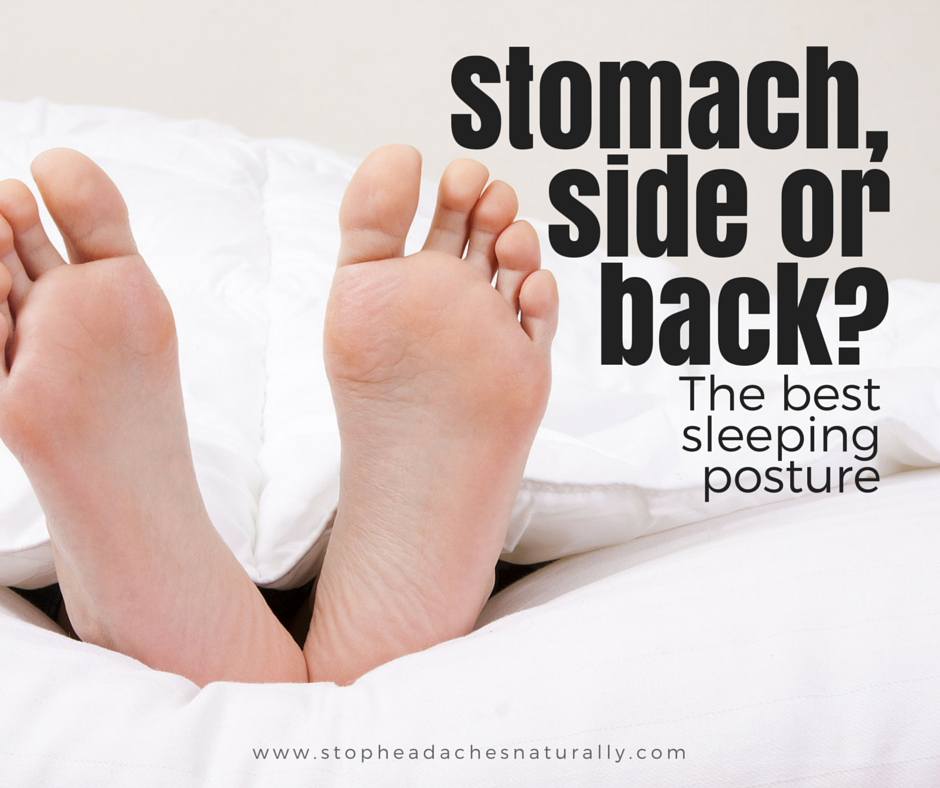
We have all woken up with a stiff neck or sore back and immediately thought, “I must have slept the wrong way”.
Most people are aware that poor sleeping posture can cause neck, shoulder and back pain. However the important role that it can play in provoking headache attacks tends to go unrecognized.
Considering we spend almost a third of our life in bed, we ought to pay more attention to our sleeping posture. Perhaps you have an ergonomic chair at work but what about the mattress and pillow on your bed?
A good mattress and pillow can certainly help your sleeping posture. Mattresses and pillows also wear out and need to be replaced regularly.
However it is even more important to look at the way you lie in bed.
Although we change our position many times while we are asleep, we all have a favourite position. This is the position that we adopt automatically as we drift off to sleep, the one we continually return to during the night. Hence it is the position that we spend the most time in. Video studies have shown almost everyone is able to identify it reliably.[5b]
Do you prefer to sleep on your side, on your back or on your stomach? There is some disagreement among scientists and doctors as to whether sleeping on your side or your back is better for the spine.
However all are agreed that sleeping on your stomach is very bad for the spine and should be avoided.
Stopping sleeping on your stomach may be one of the most effective things you can do to stop your headaches. Just what it is wrong with sleeping on your stomach is discussed in the next section.
Having good sleeping posture means that when you are lying in bed in your usual position:
- Your pillow and mattress should support your head and body so that your spine retains its three natural curves, just as when you are sitting or standing.
- Your spine, and especially your neck (cervical spine), should not be twisted to one side – your shoulders and hip bones should be aligned.
The position of your arms and legs should not put any muscles in either an overly shortened or overstretched state. For example, avoid crossing your arms tightly against your chest as shown in the photo.
Awkward positions such as this, when held for hours on end during sleep, will cause or reactivate muscular trigger points and worsen existing muscle imbalances.
Our postural habits are so ingrained that we are mostly unaware of them. It is a good idea to demonstrate the way you usually lie when you go to sleep to your manual therapist and ask them to comment on any possible problem areas that they notice.
This is an excerpt from Stop Headaches Naturally | Chapter 8 - Postural Tips For Sleeping
The Focus Of Western Medicine Is On Treatment Rather Than Prevention

“The doctor of the future will give no medicine, but will interest his patients in the care of the human body, in diet, and in the cause and prevention of disease.”
Thomas Edison
Although there have been many medical advances since Edison’s time, the doctor is unfortunately still “giving medicine”.
The traditional approach in Western medicine has always been to diagnose a particular disease or condition from known symptoms and then to treat it with medication, surgery or various procedures.
This focus on diagnosis and treatment worked well for infectious diseases, but is not very useful for multi-factorial chronic diseases like cancer and cardiovascular disease.
At the population level, the emphasis has shifted in favour of understanding the underlying causes of disease, and prevention through improvements to lifestyle.
However this has not really been translated to the individual patient-doctor consultation.
It is not just the doctor’s fault – patient expectations also contribute to this situation. Patients sometimes complain they have not got value for money if they don’t leave clutching a prescription, but just discuss factors like diet, exercise and sleep with their doctor.
Or if the doctor does recommend various lifestyle changes, patients frequently ignore this advice and keep looking for “the magic bullet”.
And when the patient is in pain, many doctors feel helpless if they can’t provide some form of pain relief.
This is an excerpt from Stop Headaches Naturally Chapter 6.8 - The focus of Western medicine is on treatment rather than prevention
Preventative Medicine... Diaphragmatic Breathing

If you are like most people you probably haven’t given much thought to the way you breathe until now.
However, factors such as stress, slumping in the chair, abdominal surgery, or even always keeping the stomach tensed and hence fashionably flat, mean we tend to adopt incorrect breathing patterns without realising it. Perhaps it may come as a relief to know those much sought after “washboard abs” are not so healthy after all.
Common examples of incorrect breathing include:
● Chest breathing (breathing high into your chest)
● Shallow breathing
● Irregular breathing
● Failing to breathe out fully
● Forgetting to breathe out at all for a while and holding your breath
● Breathing too rapidly or too deeply (hyperventilation)
● Breathing through your mouth rather than your nose
Some people who breathe incorrectly complain they tend to run out of breath while talking, others may notice feeling anxious, but many may not be aware of any effects at all.
"We often worry about what to eat and what not to eat but we can last months without food, but only days without water and only minutes without oxygen"
However correct breathing is essential for optimal physical and emotional well-being. Consider that we often worry about what to eat and what not to eat but we can last months without food, but only days without water and only minutes without oxygen.
Incorrect breathing patterns can have some surprising effects.
In Chapter 7 we mentioned that habitual chest breathing could cause trigger points to develop in the neck and shoulder muscles, and that replacing chest breathing by diaphragmatic breathing plays an important part in preventing these trigger points from recurring in the future.
But what is diaphragmatic breathing?
Diaphragmatic breathing, which is also called abdominal or belly breathing, is considered to be the normal healthy way to breathe. It means drawing air deeply into the lungs while keeping the belly relaxed and using the diaphragm to do most of the work. This causes the abdomen to expand rather than the chest.
Slow diaphragmatic breathing is how a sleeping baby breathes, its abdomen rising and falling with each breath.
It is the most efficient way to breathe, requiring the least physical effort and almost completely filling the lungs with air.
"It also has a calming effect, helping reduce emotional stress and excess muscle tension"
It also has a calming effect, helping reduce emotional stress and excess muscle tension and so is normally used as a prelude to relaxation exercises.
Slow diaphragmatic breathing can make a significant contribution to reducing the frequency and severity of your headache attacks.
It does this by:
● Removing one cause of trigger points in the muscles of the neck and shoulder muscles which are a direct source of headache pain.
● Increasing oxygen supply to the brain.
● Reducing emotional stress and excess muscle tension.
* This is an excerpt from the book Stop Headaches Naturally (Chapter 8, Correct Breathing - Diaphragmatic Breathing & Headache Prevention)
What Is Prentative Medicine?

Have you ever tried fixing a leaky roof when it’s raining? The only thing you can do is place a bucket under the leak and temporarily repair the leak.
Once the rain stops, it’s easy to remove the water from the bucket and hope it doesn’t rain again. But if this cycle continues, the leak that was once only a single drop in a bucket, can worsen to the point were the roof can buckle and cave in.
Many of us can apply this behaviour to our health. It’s important that once we experience a ‘leak’ in our health - whether its back pain, tension headache or migraine - make the time to fix it.
"Once we experience a ‘leak’ in our health - whether its back pain, tension headache or migraine - make the time to fix it"
So don’t wait until it rains again. If the sun is shining and there are blue skies, make sure you make the time to take preventative measures to ensure that your roof contains no cracks or faulty plumbing.
Stay posted! I will be providing some Preventative Medicine strategies in upcoming posts…
Why Does Stress Plus Muscle Tension Equal Headache?
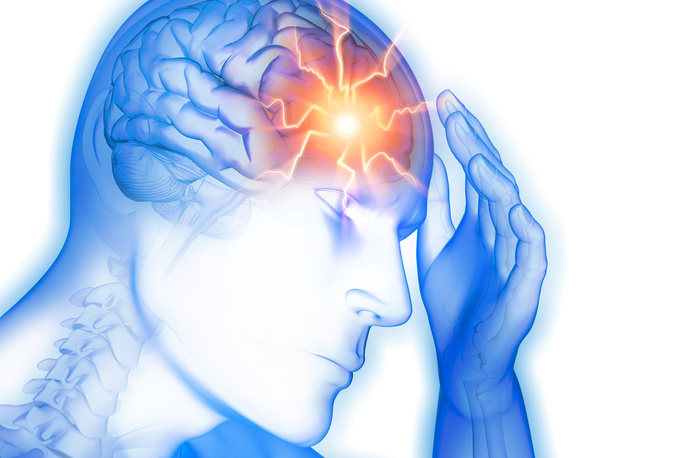
Both migraine and tension headache sufferers list emotional stress, and feelings such as anxiety, worry, fear, anger, and frustration that accompany it, as their most important trigger. But emotional stress is more than a trigger. It is part of the mechanism that produces a headache.
Emotional stress can contribute to headaches by:
- Interfering with natural pain suppression mechanisms
- Increasing the excitability of the brain
- Altering bloodflow to and within the brain
- Causing the release of histamine, a vasodilator and inflammatory substance
- Increasing musculoskeletal pain
On-going stress can lower your headache threshold, making it more likely that exposure to your other triggers will provoke a headache attack. Specific short term stressful episodes may trigger a headache attack. [12]
The role of emotional stress in provoking headaches is reasonably well appreciated. However few headache sufferers are aware that the sustained and excessive amounts of muscle tension may play an equally important role.
Nor are they usually aware of just how tight the muscles in their jaw, neck and shoulders actually are for most of the time. Sustained tension in these muscles is a common response to emotional stress.
It is also the result of maintaining the upper part of your body in a fixed posture. Sitting without moving for lengthy periods of time is a major culprit. Sitting with your neck craned forwards magnifies the problem. This “forward head posture” [13] will also cause pain in the joints of your neck.
Tight or tense muscles are muscles that are actively contracting. However, as we have seen, when muscles stay contracted for too long without relaxing they start to suffer microscopic tissue damage. Various inflammatory substances are released into the muscle fluid from where they are transported into the blood stream.
"when muscles stay contracted for too long without relaxing
they start to suffer microscopic tissue damage"
Hence on-going tension in neck, jaw and shoulders acts as a continual low level source of pain which can reduce your headache threshold. If trigger points are present, tension may irritate them sufficiently to provoke a headache attack.
Muscle tension, like emotional stress, lowers your headache threshold, making a headache attack more likely. Muscle tension can also act as a headache trigger.
[12] JM. Nash and RW Thebarge (2006). “Understanding Psychological Stress, Its Biological Processes, and Impact on Primary Headache.” Headache 46(9):1377- 1386.
[13] DG Borenstein, SW Wiesel and SD Boden (2004). Low back and neck pain: comprehensive diagnosis and management, p231-233, Edition 3, Elsevier.
How To Be A Smart Smartphone User

If you use a smartphone or tablet for more than one hour everyday, you definitely need to learn how to use it more intelligently… and no, i am not referring to another new app that will help you streamline your workflow.
The exponential growth in mobile technology has made it possible for people from all walks of life, young and old to own a mobile device. People not only using mobile devices for texting or phone calls but to read emails and eBooks, interact within social-media circles, play games and watch videos. This forces them to hold their necks in a bent position for long periods, creating excessive strain on the ligaments, tendons and muscles of the cervical vertebrae.
Unfortunately many of us ignore the aches and pains that occur while using our mobile devices, but it is only a matter of time before we begin to experience more serious problems like:
• Tension headaches
• Blurred vision
• TMJ syndrome (jaw pain)
• Joint pain
• Muscular tension and stiffness in the neck, shoulders and back
• Tingling down the arm and fingers
What is the real cause behind the neck pain
Your neck is at its most relaxed and comfortable state when the weight of your head is positioned directly on top of your spine. The muscles around the front, back and side of your neck should be working together to hold your head in a neutral position – looking straight ahead - this is the most natural state or position of the neck. So when you use a mobile device for prolonged periods with a bent and rotated neck, this will create an unnatural position, which leads to overuse injuries.
Of course, bending and turning your neck in various directions is encouraged because the cervical vertebrae are designed to facilitate free movement in all directions. However, you must be aware of your posture and make sure that your neck does not remain in awkward positions for long periods and returns to the neutral position.
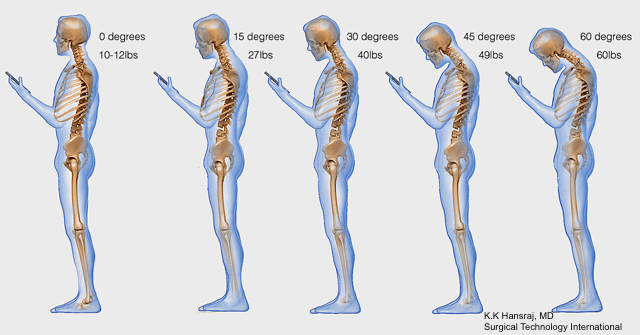
On average, people use mobile devices for two to four hours a day. In other words, our necks are bent and held in a forward head position for 700 to 1,400 hours every year. It is the cumulative effect of years of overuse and stress that leads to degeneration and serious neck and back problems.
How to minimize the damage
Dr. Ezriel Kornel, a neurosurgeon from New York has offered some suggestions for computer and mobile users to reduce the damage caused by poor posture:
• Keep your phone or tablet at a higher level so you are not continually bending your head forward
• The Alexander technique is beneficial as it helps you become aware of how you use your body and teaches you optimal body positioning and poise
• If you suffer from neck pain or headaches, use mobiles phones in moderation to help reduce excessive strain on the neck
• Take frequent breaks. Stretch your neck and reposition your body to relieve the accumulated tension (using an app to remind you can be very useful)
Whether you like it or not, using a mobile device has become a part of our daily lives and it is here it to stay. So it is important that you are aware of the negative effects of prolonged mobile use, especially with your neck bent forwards. Not only will it improve your posture but it will also decrease your stress levels, reduce muscular aches and pains and be one the keys to stopping your headache and migraine pain… you will have become a smart smartphone user.
________________________
Pablo Tymoszuk is a soft tissue therapist specialising in remedial, myofascial and dry needling techniques. He also acts as an ergonomic specialist and wellness consultant which has motivated him to co-author the eBook Stop Headaches Naturally.
Together with Dr Margaret Scarlett they present a range of strategies for stopping headaches and migraines without drugs. All strategies are organized in a systematic manner and backed up by references to the scientific literature.
Smartphones Are A Hazard For Posture

Our smartphone obsession is putting Australians at risk of becoming a nation of hunch-backs, experts fear.
Chiropractors and physiotherapists are reporting a marked increase in the number of patients being treated for neck and shoulder complaints due to smartphone use.
Arthritis and Osteoporosis Victoria forecasts cases of arthritis and other musculoskeletal conditions will almost double to 8.7 million Australians within 20 years, with health costs estimated to be around $4.8 billion a year.
Australian Chiropractor Association spokesman Dr Michael Black said patients were experiencing headaches, upper back pain, sprains and muscle spasms. “While many people are tablets it appears that their ‘normal’ postural positioning has transformed people to developing rounded shoulders and subsequent forward head carriage leading to upper neck and upper back pain, resulting,” in headaches or migraines.”
Herald Sun | Richard Noone
Are suffering with headaches, back pain and spasms?
Do you need some help improving your posture?
Then have a look at just a few sections of Chapter 8 in the book Stop Headaches Naturally
IMPROVE POSTURE
- 8.2 What does having good spinal posture mean?
- 8.4 The wall test to assess and improve spinal posture
- 8.6 Modern work and leisure sets us up for bad posture
- 8.7 Mobile electronic devices and forward head posture
- 8.9 Set up your computer to minimize postural stress
CORRECT BREATHING
- 8.18 Diaphragmatic breathing & headache prevention
- 8.19 Learn how to breathe using your diaphragm
RETRAIN CORE MUSCLES
- 8.20 Spinal posture and the core postural muscles
DO SPECIFIC EXERCISES
- 8.21 Why exercises are important for headache prevention
- 8.23 Two part exercise for correcting forward head posture
Pablo Tymoszuk is a soft tissue therapist specialising in remedial, myofascial and dry needling techniques. He also acts as an ergonomic specialist and wellness consultant which has motivated him to co-author the eBook Stop Headaches Naturally.
Together with Dr Margaret Scarlett they present a range of strategies for stopping headaches and migraines without drugs. All strategies are organized in a sy





